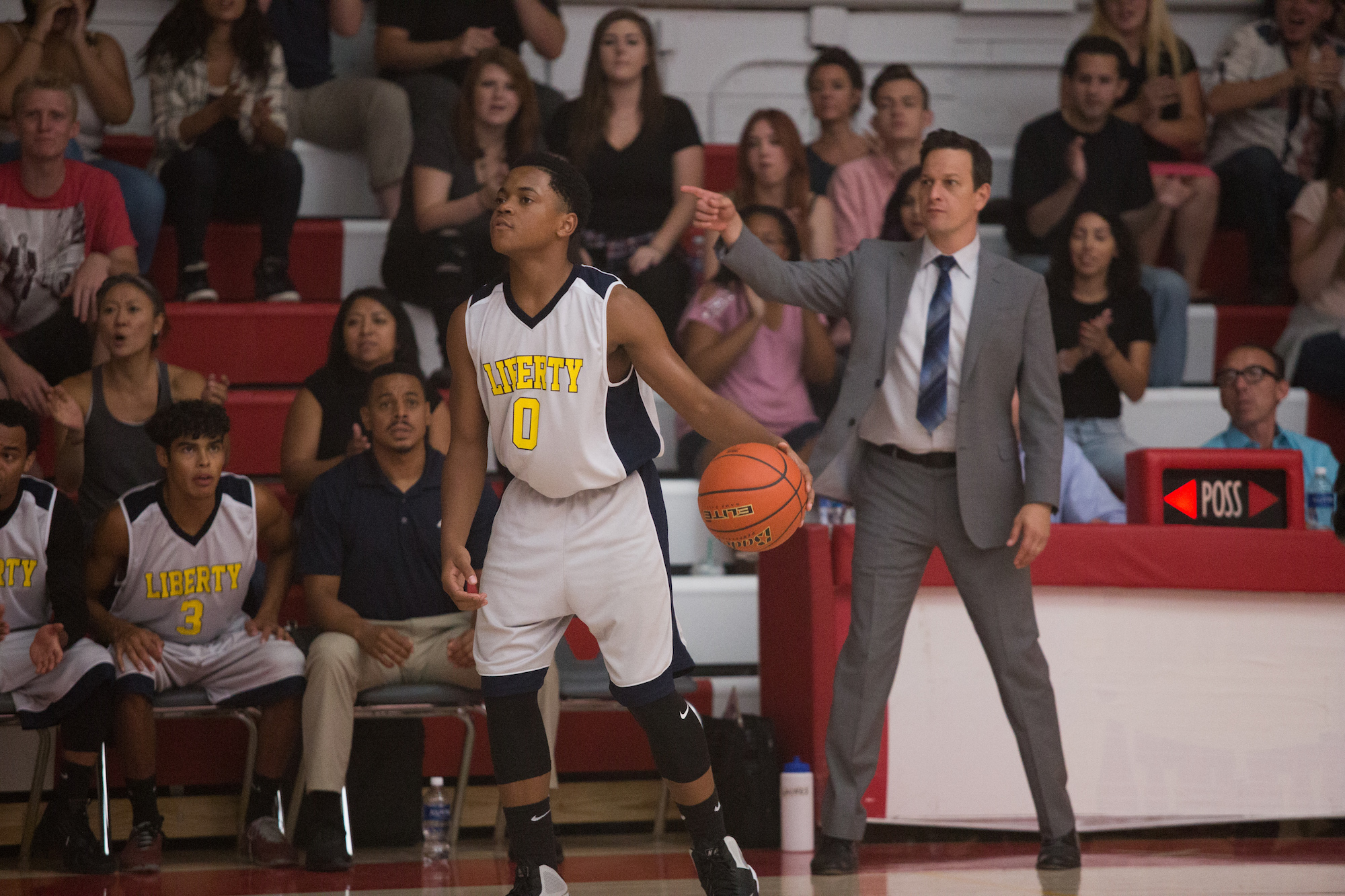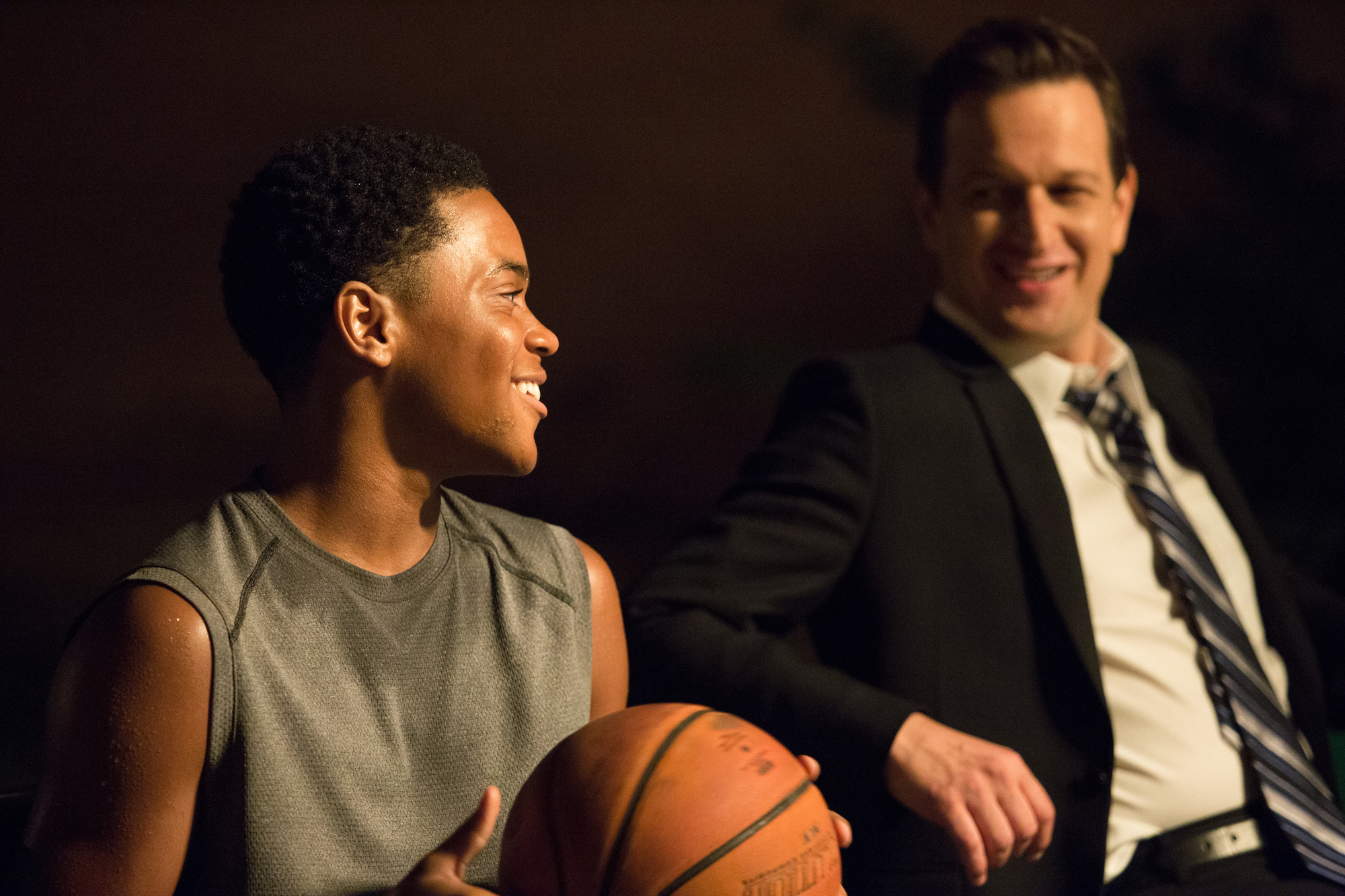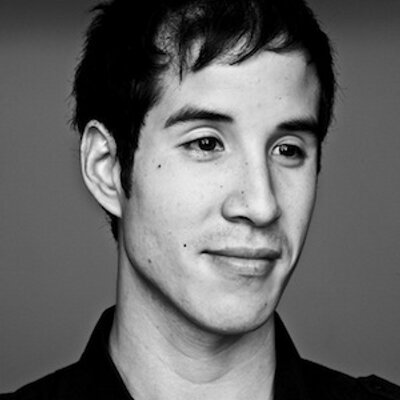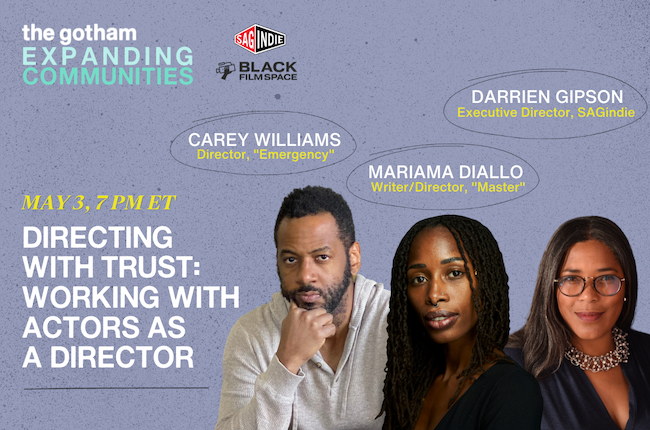The entrepreneurial spirit is evident in practically all independent filmmakers. Each film project can feel a little bit like starting your own small business in which you’re the CEO. In the case of filmmaker RYAN KOO, he actually did start his own company and is a CEO – all while balancing his own work as a screenwriter and director. What began as his personal blog about film production quickly grew into a hugely successful online resource for independent filmmakers: No Film School.
In the middle of building No Film School into a success, Koo didn’t pause his own filmmaking ambitions. He wrote, directed, and produced the short film Amateur in 2013, with plans already underway to expand the story into a feature. The feature version of AMATEUR is now available to the masses as a Netflix Original Film. Amateur tells the story of Terron (Michael Rainey, Jr.), a 14-year-old basketball prodigy recruited to play for a prestigious NCAA prep school. Josh Charles co-stars as the school’s smooth-talking coach, with Sharon Leal and Brian White as Terron’s conflicted parents. The film is now streaming on Netflix.
Ryan Koo was nice enough to talk to us about making Amateur and his work as a writer/director and a Founder/CEO.
——
COLIN McCORMACK: The process of writing the feature to making the short to doing a Kickstarter and then making the feature was sort of done in an unconventional order. Could you explain how that series of events played out?
RYAN KOO: It was definitely an unconventional order, and I don’t know that it’s the order I would recommend other filmmakers do it in. [Laughs] The reason that I’d done the Kickstarter campaign so early was because I had been selected by an IFP program and they were going to be reading the script on stage. So it was sort of getting out there publicly and I felt it was a good time to leverage that into a Kickstarter campaign. Obviously, I had no idea that it was going to take years and years to have the feature come to fruition but at a certain point, after I’d already done the Kickstarter campaign, I felt that I hadn’t directed anything that was of the same genre or that was about basketball. So that was where the short came from, to try to create a proof of concept that was more doable than the entire feature and to leverage that into helping us get the feature made.
CM: Because it took so long from doing the screenplay and then the short and then working on the feature, how did you stay passionate about the idea and not get burnt out on the story? Were there times where you had to step away and come back to it with fresh eyes?
RK: Definitely. The way I stayed passionate about it was that I had picked the right topic for myself from the beginning. I had picked basketball, which I am unreasonably passionate about to start with. That was part of the reason I wanted to make the movie was that I knew I was going to hear “No.” I didn’t know I was going to hear “No” as much as I did [laughs], but I did know from the get-go that the enormity of the task would be potentially depressing and defeating. In order to not lose steam I needed something that I really cared about, and for me that was basketball. And I did step away; I would work on a draft for a month or two and then not look at it for a month or two and that was how you can come back to it with fresh eyes.
CM: During those times where you were either stepping away or working on something else, how did you keep your Kickstarter donors engaged and keep them from getting antsy for something they invested in?
RK: At a certain point it’s really difficult to do that. It was easier in the early days, but [harder] once the timeline stretches on. I would keep them updated, but there’s only so much that you can say about the screenwriting process because essentially you’re just going back to your laptop and writing again. And that’s not an interesting update to read as a Kickstarter backer. Like, Oh, you’re still writing? Okay… So for me the way that I looked at it when I updated them I would be like, “Hey, you backed me to work on this film for potentially a year or two. Now, as a result, the movie is getting better and it’s going to be bigger and it’s going to find a larger audience and it’s something that hopefully you’ll be even more proud of backing.” But essentially for that same number of backers and that same amount of money, I’m now working on it for more years. It’s not like it’s just taking longer, period. I’m actively working on it. So whatever you believed in me, now I’m just working that much harder for that same about of belief.

CM: Had you already made the short film when you were accepted to the Sundance Screenwriters Lab?
RK: Yes. I think the Screenwriters Lab is incredibly competitive and there are a lot of writer/directors now, so if you’re going as a potential writer/director and not just a screenwriter, then I think you also need to show your potential on the director side for that material. I had been rejected from the Sundance Lab for at least two years in a row prior to getting in. And one of the big differences was that I made the short between rejection and acceptance and part of the package that I applied with was having that short and them being able to see my vision for the material. I can’t say for certain, but I think that was instrumental in getting in.
CM: Were there any things at the Lab while you were going through it that you locked in on that changed the direction or opened your eyes in a different way in expanding from the short to the feature version?
RK: It’s interesting, the short and the feature are very different. The short was sort of an idea I had on the side while I was working on the feature, so I think the feature was going to succeed with a different tone and relied on different aspects than the short. One of the things at the Sundance Lab that I learned about and explored was the emotion of having a much younger kid in the feature and really fully exploring that. I think that the script that went into the Sundance Lab was not nearly as emotionally available as what I came out with and what ended up being a strength for the feature.
CM: In casting your lead and his teammates, what was that balance between finding an actor who could play ball versus a basketball player who could act, or whatever the perfect combination was?
RK: I actually had thought in advance that we would be doing the latter, that we’d be looking at a lot of basketball players and then working with somebody as an actor. As it turned out, Michael Rainey, Jr. had been an actor for years but also happened to be a big basketball player in his free time as a point guard. It was a passion of his. So I think that ended up being one of the only ways we could make this movie because this is a real-life teenager in the starring role, in every single scene. And it’s one thing to add acting as a basketball player if you’ve never done it before, but that would’ve been a lot for a non-actor to take on, showing up to set to do it all day every day for weeks. So I think the fact that we had a genuine teenager, a real kid – he was 15 when we shot the movie playing 14 – and the fact that he had acting experience and could really play basketball, we really relied on all of those things.
CM: Was it almost like choreography in terms of the basketball scenes? How much training and rehearsal time did you have to go through to pull off all those scenes of people playing?
RK: We didn’t have a lot of time. I had actually done some choreography and rehearsal of it in advance in a gym just with my Director of Photography [Gregory J. Wilson] and myself as Terron Forte and whoever else on the crew knew anything about basketball. We hired a high school coach in the area, Rudy Martin, who had never been a basketball coordinator, mainly to help us with making sure all of the non-main characters – the people in the background – were moving in a believable way because we were going to be focused on the choreography of the principal characters. So we did some rehearsals and some blocking in advance, and then when Michael showed up to town we did some more with him. But a lot of the times we were thrown a curveball during production and we wouldn’t have enough extras to be able to look at this part of the gym, or the gym was different than we expected, so there was sort of a combination of trying to choreograph as much of it as we can but then also being able to reinvent the wheel on the fly.
CM: I’m sure Michael’s own experience and instincts with the game probably helped with that too when you had to change things. So he’s not just an actor going through the motions of the choreography, but he actually knows the game.
RK: Exactly. If he had not been a real basketball player, then we probably would have carefully rehearsed every single move that he does in the movie and that would have been all he’d been able to do. But because he’d been playing and I put him with a basketball trainer for months leading up to the movie to make sure we were working on specific things – but also just that he was going to be in shape and in rhythm – that way when we had to change something he still had something in his arsenal that he could go to. So I could say, “Actually, we’re going to be on the other side of the court and instead of a crossover it’s going to be a spin move,” and he could just do that like a real basketball player.
CM: In terms of the basketball scenes from a visual standpoint, how did you come up with how to shoot those? There are a lot of ways you could either look at sports films or films in other genres, whether it’s handheld or slow-motion or wide shots. How did you and your DP come up with the visual style of each game?
RK: The objective was always that I wanted to have the movie simulate the experience of being a player, not a spectator. What I had seen in so many sports movies is that it looks similar to what you see on TV, which is it’s shot from the sidelines. It’s the experience of watching someone play a sport, and you have a radio announcer explaining to you on the audio side of things what’s going on and who’s ahead. Having grown up as a basketball player myself, none of those things are the case. So I wanted to keep it to his world and to keep the camera as close as possible to him. That’s a challenge in sports movies; it’s harder to do it because you’re putting a dolly, you’re putting a Steadicam, you’re putting equipment right in the middle of the court. But that was from the very beginning our objective, and we also wanted the sport to feel thrilling and for him to feel powerful on the court in ways that he wasn’t off the court. So it meant going to high-speed photography and we used an entirely different set of lenses for the basketball than we did for all the narrative scenes. We really just wanted to have him exist in two different worlds and the cinematography and the visuals were a really big part of that.
CM: In terms of logistics and your locations, you have not only his original school and then the new school her transfers to and away games. How many gymnasiums did you guys have to find and get permission to film inside?
RK: The key for us was to try to find locations that we could use more than once in the movie. We couldn’t afford to be at as many schools and gyms as you see in the movie. So there’s actually one school that I think ended up playing four schools in the movie. It had multiple gyms, the locker room, the exterior, the hallway – we would strategically use them and dress them for different moments in the film to try to find a more efficient way of making a movie that looks much bigger than it is. That was a really complicated location scouting process, where I created a spreadsheet that had checkmarks for all the different locations and essentially it ended up starting to look like a Tetris game, trying to make all these blocks fit into place.
CM: You filmed in Denver?
RK: Yeah.
CM: Did you have roots there or any connections to the filmmaking community or were you hiring people based on recommendations or word of mouth?
RK: All of those things. I’m actually from North Carolina and I based the script on some schools in that area. The objective was to have it be sort of placeless and to have it be somewhere in America so it could apply to a lot of different places. So we didn’t have a specific need for one state versus another.
CM: I definitely wouldn’t have pegged it as Colorado if I hadn’t looked it up.
RK: Yeah, we were trying to avoid the snow-capped mountains, which would have given it away.
CM: The phrase “Netflix Original Film” can be somewhat confusing because it applies to the films they produce in-house as well as projects they acquire at festivals. When did Netflix become involved in Amateur?
RK: They actually financed it as a Netflix Original Film at the script stage, so it was not a pickup later. This was actually one of the first movies they signed up to make and that was as early as– I think it was late-2015. From the minute when they financed it, it was always going to be a Netflix Film. In the early days, we didn’t necessarily know what that meant because they’d only done series at the time. But it was really exciting to sign that deal and to know the size of the platform that we were eventually going to be premiering on.
CM: You hear this a lot with their series specifically, but I haven’t heard it as much regarding their films in terms of the amount of creative freedom they give their creators and minimal notes. Did that seem to apply on their feature side as well?
RK: Yes, absolutely. I was trying to get this movie made for years and in many cases other production companies or places I had taken it, a lot of the questions that I would be asked were about how could I change it to make it more viable, to bring the budget down, to make it more commercial, whatever the changes were. Whereas when I took it to Netflix they said, “We want to make this movie.” They gave me the creative freedom to make the movie that I wanted to.
CM: Switching to No Film School for a little bit, when you first started it as your personal blog, what were some of the early topics or information you felt as a filmmaker weren’t as readily available that you wanted to put out there and share?
RK: In the early days I think it was really about cinematography because before large sensor cameras like DSLRs, just the aesthetic of DIY low-budget film projects was so bad with digital video and small sensor cameras that even if the story was good it was so amateurish that you couldn’t really get to the level where an audience would suspend disbelief. So in the early days in terms of the overall question of how filmmaking is changing, we were exploring a lot of how are low-cost cameras coming of age and allowing you to tell stories at a higher level at lower budgets. But over the years as it’s evolved I would say more of the questions have become about the business and the distribution side of how do we sustain careers and how do we get our content actually seen. Because there’s been such an explosion of content thanks to digital cameras and thanks to iPhones and all these things that the cinematography is no longer the question, it’s everything else.
CM: One of the regular – and particularly helpful – series of postings on No Film School is the seasonal listing of grants with upcoming deadlines. As somebody who went through the grant application process for Amateur, did you feel extra prepared when you were applying or did it still feel like uncharted or scary territory?
RK: I think the more I applied for, the better I got at elucidating what it was about the project that I felt made it worthwhile. It was great to receive multiple grants from places like Tribeca and Sundance, but I think every filmmaker should know that for all of the successes you hear of somebody having, whether that be with grants or with awards for the actual film, there are many, many more [rejections]. For every win, there are many losses. I definitely applied to more places than that and I think in some cases applying for one and not getting it would sometimes lead you to refine your language for the next one and maybe that is how you got the next one.
CM: You also have a new podcast out called The First Feature that goes through the different stages of your film, and are you talking to other filmmakers as well?
RK: It’s really just going through my film, because I felt like we’ve done so many interviews at No Film School where you have somebody who has years and years of experience but we’re at a festival and they’re doing their press tour and we have 30 minutes with them and they have five years of experience on this project. We would not ask another filmmaker, “Hey, can you give us 10 hours of your time?” [Laughs] But I can do that. I throughout this process felt like I was learning so much and that the whole mission statement for No Film School – to share what we as a community are learning with others so we can all be better filmmakers – that when it was all over I felt like the podcast was the perfect in-depth format to explore each phase of production. No one wants to watch 10 hours of video of someone sitting there, but as a podcast you can listen to it while you’re driving or while you’re doing your laundry or while you’re prepping a camera package or whatever it is, and hopefully there’s a lot in there because it was certainly the greatest learning experience of my life.
CM: In terms of transparency – because I assume you’ll be sort of reliving the good, the bad, and the ugly about film production – do you feel a freedom with Netflix that you’re allowed to do that? Whereas maybe other traditional studios, when a filmmaker is on the junket circuit like you talked about, they might have a little more control over how deep you get into the production process?
RK: I think so. I think also because when I brought the project to them, they already knew that it had been a Kickstarter film. They already knew about No Film School, so this is not a new development that I’m somebody that’s out there talking about the process. And I think that’s the other thing, I’m talking about process on the podcast, as opposed to naming somebody that let the film down or something. It’s more about the lessons that I learned, and if anybody made a mistake and learned from it, the thing that I’m sharing on the podcast is when I made mistakes and not getting into finger pointing or anything like that. Really what we’re trying to communicate is the difficulty of the journey and that that is what makes it all worthwhile and so rewarding.
CM: The fact that it’s on Netflix sort of alleviates the pressure to do the huge blitz of promotion for that opening weekend. You can go more into depth and draw out the podcast over multiple weeks and the film is still there available for viewing. Did that cross your mind when you were thinking of different ways you could leverage No Film School as a promotional arm?
RK: It definitely did. That’s one of the things that I’m really excited about for the film, for the life of it to be on Netflix to find new audience members. As indie filmmakers, often by the time you finish the movie you’re so exhausted from the process of actually having finished the film that to take on a more DIY distribution approach is really daunting. We haven’t actually done that much on No Film School about the movie other than this podcast, because independent film is a niche and compared to 120 million Netflix subscribers, No Film School is kind of a drop in the bucket [laughs]. So I wanted to do the podcast for our audience specifically, as it feels like wrapping up what’s been a seven-year journey. But what’s really nice is to feel like I don’t have to be scrapping for every individual viewer because the movie – by virtue of being on the platform and Netflix’s algorithms and everything – it has the largest machinery possible behind it and it’s reaching an audience through much more than my own efforts.
CM: Is there anything on the filmmaking side or the website side that you’re excited to have coming up?
RK: At No Film School we’re excited to be doing more education in the future in terms of the “school” part of our name. I think this film kind of represents that journey for myself that you can learn a lot online. I hope that The First Feature being a much more in-depth long format podcast is helpful for others by virtue of it being a deeper dive. I look forward to us doing more long-form content.

__
Thanks to Ryan for talking to us about AMATEUR and his other work! Follow the film on Twitter or Facebook. You can also see Ryan’s work at NoFilmSchool.com.
If you’re an independent filmmaker or know of an independent film-related topic we should write about, email blogadmin@sagindie.org for consideration.



